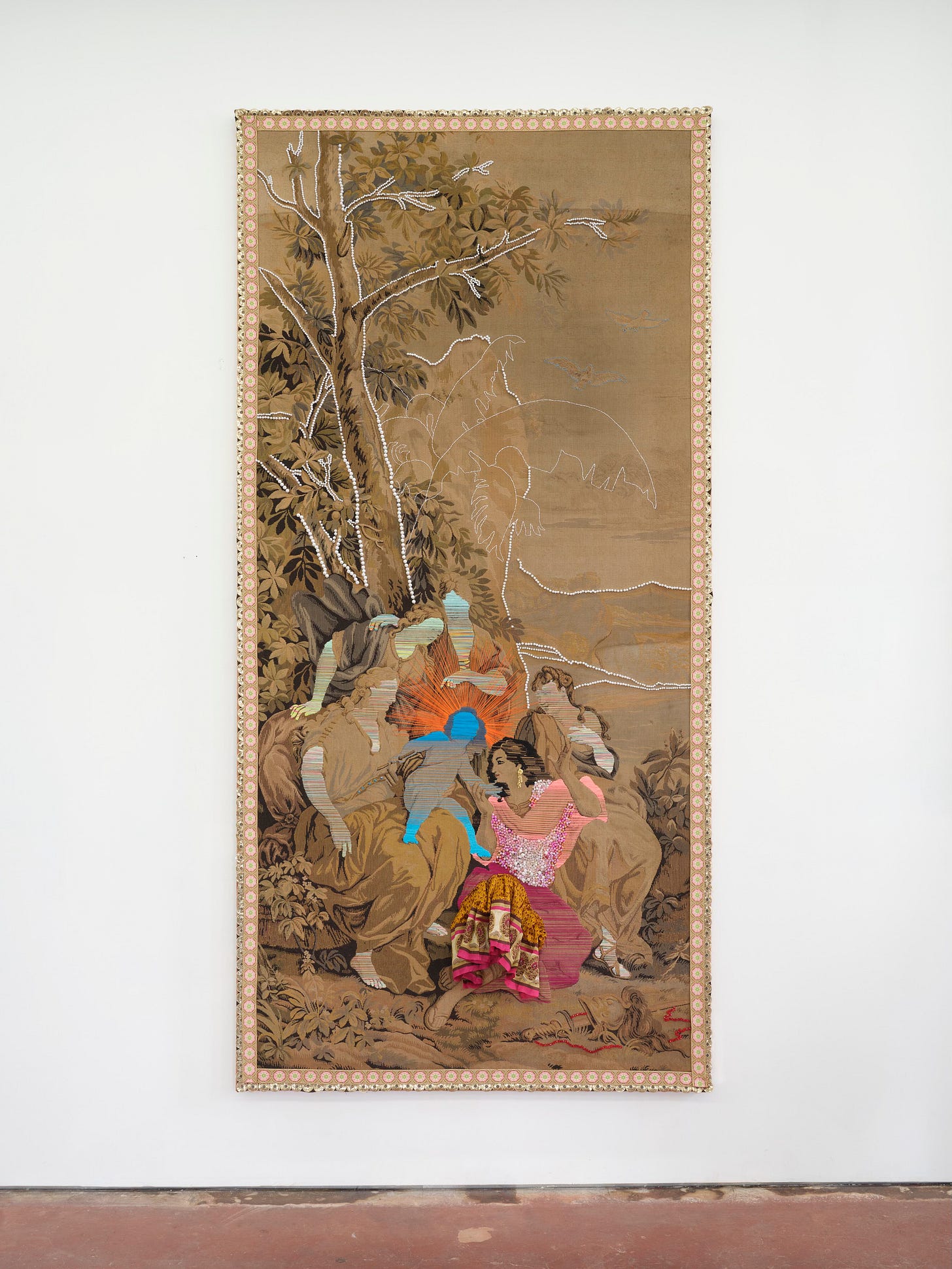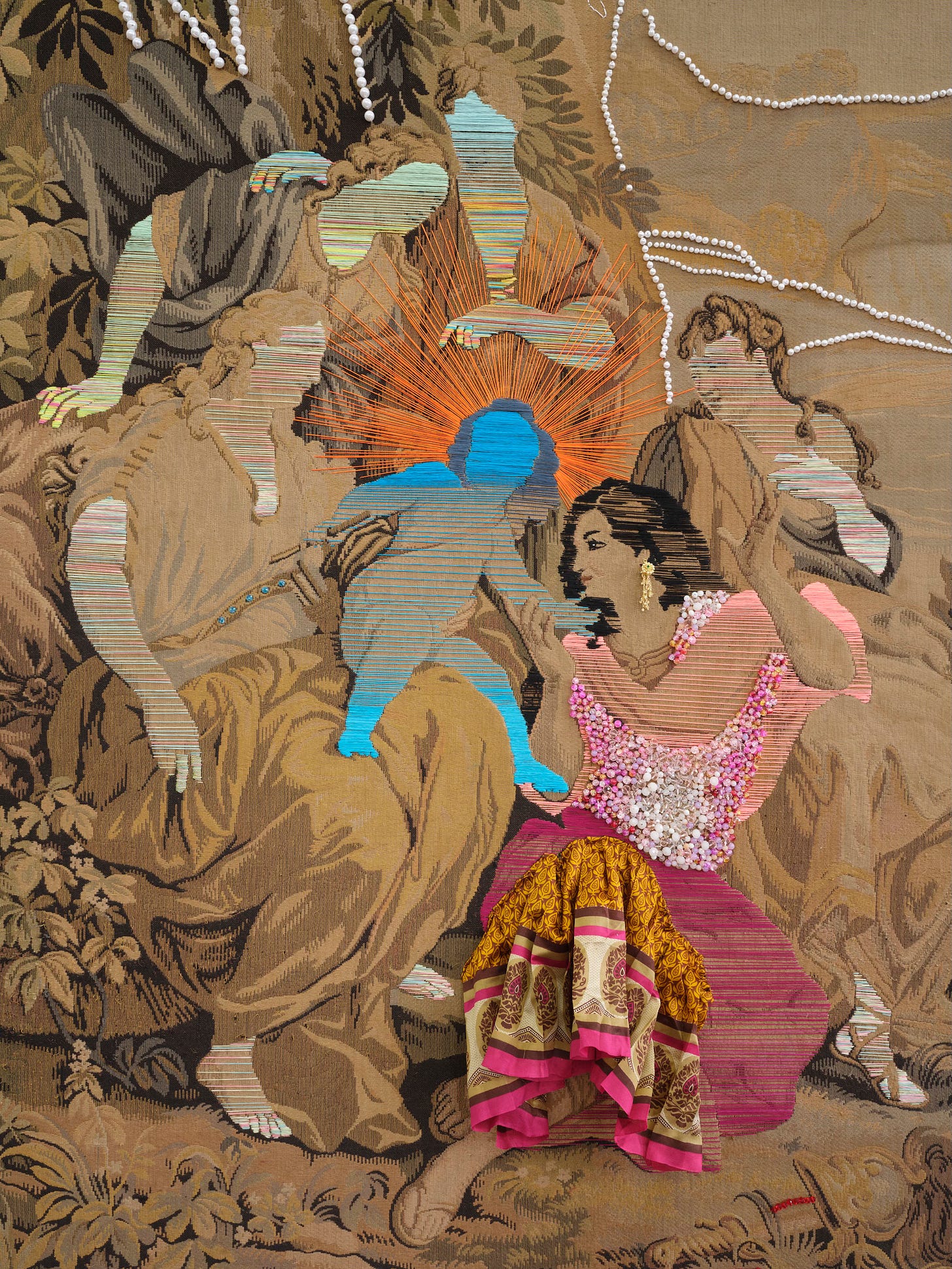
Textiles are a shared language for my older sister, Suchitra Mattai and me, evolving from our South Asian heritage and the Guyanese-Indian culture we grew up with. As children, our mother taught us to sew and crochet, passing down the domestic arts she learned from our grandmothers, who were both accomplished seamstresses. While my interest in textiles manifested as a career in design, Suchitra has become an internationally acclaimed artist with an innovative studio practice. She uses traditional textile techniques in unconventional ways to connect historical, political and personal narratives.
Her latest solo exhibition with LA gallery, Roberts Projects, is entitled “In the absence of power. In the presence of love.” The concept began with the title itself, and a desire to create a kind of utopia imbued with feminine energy. “I wanted to create a space where we could imagine a world without hierarchies, colonialism, and patriarchy. I have always considered my process to be one of re-imagining colonial histories and making space for the narratives of people whose voices haven’t been heard,” she shared.
As we walked through the gallery, I knew I wanted to focus on the exhibition’s titular work, a ten-foot tall vintage tapestry embellished with embroidery, beading and appliquéd sari fabric. In Suchitra’s words, the piece was a “poetic incarnation of the show’s title,” and it had a narrative quality that drew me in.

The foundation of the artwork is a scenic European tapestry originally featuring a group of goddesses clustered around a winged cherub. Embroidered lines obscure, illuminate, and ultimately transform these female figures. Like visual glitches disrupting the scene, the embroidery’s gradation of color shifts between pastels and brights, contrasting with the faded linen tones of the tapestry.
The cherub has been recast as a baby girl with an orange halo radiating from her crown, giving her an otherworldly presence. Her face and body are embroidered in shades of cerulean, referencing the blue skinned god, Lord Krishna, from Hindu mythology. The figure in the foreground - perhaps the mother? - is given the most lifelike appearance, with embellished features and decorative clothing. Playing off of the woven folds in the garments, a sari fragment has been gathered and placed over her legs, lifting off the two-dimensional plane. In conversation, my sister spoke of wanting to recast the goddesses as ancestral spirits celebrating the birth of the girl-child, holding her in a circle of love and support.
The pastoral scene above the women is disrupted by lines of pearl beads, and the outline of palm trees, a nod to the Caribbean landscape. In the foreground, the warrior’s helmet and sword - those symbols of male power - are discarded, cordoned off by a red beaded line, like a trail of blood. Framed with glittering decorative trim, the work’s modern, and in some cases, intentionally synthetic elements merge with the aged texture of the document fabric to create a new visual language.
Through this play of materials, past, present and future narratives collide, reminding us that we cannot tell one story without the other. Over a hundred years ago, our ancestors were brought from India to Guyana, South America to work as indentured laborers under British colonial rule. Drawn from the trauma of displacement, the work offers an alternative mythology that speaks of rebirth, repair and reclamation.
Walking the show with my eight-year old son, I felt inspired and uplifted, not to mention incredibly proud. Like the heroines of the piece, my sister is guiding the next generation of our family into a new era, one that celebrates artistic achievement and encourages us to shift our collective consciousness. I’m grateful we were able to see the exhibition, and I can’t wait to see what she creates next.

Links
For more information about the exhibition, please check out the links below:
Suchitra Mattai’s website and Instagram
“Suchitra Mattai’s European Pastorals Make Brown Women the Main Character,” by Harley Wong, Freize.com
“Suchitra Mattai Envisions a Future of Brown Reclamation” by Ayesha Le Breton, Observer
Thank you for reading!



